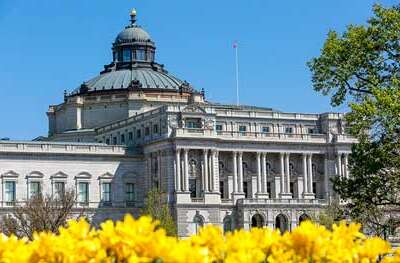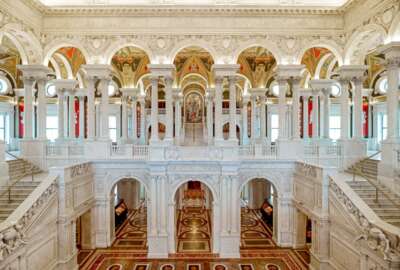
The Library of Congress brings in an outsider to take over a public-facing division
The Library of Congress has chosen Dennis Clark, an academic librarian, to come to Washington to head up its Research and Reference Service Division.
Best listening experience is on Chrome, Firefox or Safari. Subscribe to Federal Drive’s daily audio interviews on Apple Podcasts or PodcastOne.
The Library of Congress has chosen an academic librarian to come to Washington to head up its Research and Reference Service Division. I was wondering what this job does and why it matters, and I thought you would too. So Federal Drive with Tom Temin spoke to its new chief, Dennis Clark.
Interview transcript:
Tom Temin: Mr. Clark, good to have you on.
Dennis Clark: Thank you very much, Tom, great to be here.
Tom Temin: And you do come from Arkansas, but you have had experience in and around the DC area. Just give us a quick recap.
Dennis Clark: Yeah, that’s right. I was over public services at both the libraries at VCU, Virginia Commonwealth University, and University of Virginia for about 10 years. But most directly, I was that dean of libraries at the University of Arkansas and faithful.
Tom Temin: Alright, so now you’re going to be in old DC as the chief of research and the reference Services Division at the LSE. What is that job all about?
Dennis Clark: It’s a great question. I think the Library of Congress is this terrific organization that has lots of good feeling about it. But sometimes people don’t really understand what it is the Library of Congress does. And if the Library of Congress has even for anybody, but Congress. And so the answer to that is yes. I mean, I think statutorily the Library of Congress is literally Congress’s library. But we also have a mission to provide the nation the finest possible research, the finest possible collections that are found anywhere. And as such, we are the world’s largest library. My position, which is chief of the Research and Reference Services Division, is fundamentally basically the first stop for Congress and researchers to come to find information that they need for whatever legislation. For instance, members are working through or whatever deep scholarly connections that anybody needs to our collections. The cool thing about the Library of Congress is, although yes we are Congress’s library, we are also the library of last resort for almost the entire globe. So we have resources and collections that are just not found anywhere else. My job is to try to make that conduit from the researcher to the collection.
Tom Temin: Alright. And when you say researchers can also come to use the services and the collections that you oversee, what does that mean besides members of Congress and staff? Can academic researchers, can people from the public go in there?
Dennis Clark: Yes, anybody who was 16 years or older can use the collections of Library of Congress. That’s something I don’t think everybody realizes and what Dr. Hayden, the Librarian of Congress, is trying to do is to make sure that everybody knows, that everybody understands that the Library of Congress is really the nation’s library. And so anybody who’s 16 years or older can come and use the collections of the Library of Congress if they have a need to do so. And that typically, as you can imagine, are people that are working on fairly deep questions of research, or they’re trying to get access to collections for scholarship on maybe they’re writing a book, maybe they’re writing a play, maybe they’re engaged in dissertation, those are often who we see. But we also have deep resources and local genealogy for the DC area, for the Delmarva, the whole area in the Mid Atlantic, and also connections to genealogy nationally and internationally, local history, we see a lot of high school kids coming in using our collections, and basically being wowed by what they have access to. And it kind of sets them on a different path, maybe in their own score.
Tom Temin: And suppose I have a need for research on I’ll pick a topic that probably there’s a lot of resources on the history of intellectual property and how it’s treated by the federal government. That’s a hot topic. And I want to use the Research and Reference Services Division, what do I do? It’s not like you can go into the county library and walk in and there’s stacks of books and tables, and so forth.
Dennis Clark: You can’t do that right now, because of the restrictions on COVID. But you will be able to do that when we’re open and taking visitors. Anybody with an ID can walk in, get a reader’s pass and begin using the collections immediately. Currently, obviously, the libraries are closed to visitors, unfortunately. But we do have a robust what we call an Ask a Librarian service where anybody locally, nationally, internationally, can ask questions and our reference librarians will take that question and try to research it for them as deeply as they can through email or through chat. And we do that all day long, five days a week. But we’re engaged in responding to reference questions, reference queries, research questions all day long from around the globe.
Tom Temin: But in ordinary times, a person could walk into a library of congress building and do that for themselves.
Dennis Clark: Absolutely. First step is to make sure you have a photo ID and come into the Jefferson Building and we will be able to set you up with what’s called a readers card or readers pass. And then you can use one of the 20 different reading rooms, depending on your subject of interest, or what you’re trying to find more information about.
Tom Temin: And what do people encounter? Is it almost all digital online on a screen, or do people still avail themselves of printed books in the physical manual?
Dennis Clark: Yeah, that’s a terrific question. So the Library of Congress collections are obviously vast and deep, there’s more than, I have a hard time as a fairly new person at the library to be able to put the right number on it, but there’s more than 167 million individual items in the Library of Congress. And so the vast majority of those are still in print, they were published in print, they remain in print, and we have the ability to make sure those collections are brought from any number of our facilities to the researcher when they have that need. A significant program of the Library of Congress is to digitize as much of our collection as possible so it’s not just available to those who are able to come to DC to get a readers card and to sit in our reading rooms, but it’s available globally. It’s available to everybody in the country and around the world. And so that process will take a longer period of time that I can possibly fathom, certainly well beyond my lifetime. But that is ultimately the mission of the library is to digitize as much of its collection as possible. In the meantime, we serve both our digital collections, as well as our print collections, and the expertise. And it’s so important, the expertise of the people who work at the Library of Congress, the reference librarians, the staff, who know how to navigate that complex millions of resources in order to connect the researcher or the question with the collection or research resource.
Tom Temin: Right. And we should also point out that a great deal of the collection of the Library of Congress is audio recordings, film and imagery too, so a lot of that’s been digitized so that you can call it up easily to correct.
Dennis Clark: Absolutely, absolutely. Those things that are so evocative, the visual is something that I know is a major part of what we’re doing. We’re digitizing things in the Prints and Photographs Division, we’re digitizing audio, and there’s things there in copyright, we’re trying to make sure those are available as much as possible. And we have priorities, the library has established priorities of digitization, and they’re following that and trying to put more resources into that every day. And by the time they’re done, all the formats will be obsolete, and they’ll have to do it all over again. But that’s a story for another 25 years from now. And that’s why we are so excited to keep the original print versions as long as we possibly can, because the analog the paper, the print is so important when you look at long term preservation strategies.
Tom Temin: And what’s the big thing nowadays in library management, in library science? I mean, a number of years ago was the digitization of the reference finding materials and libraries, chuck these vast card catalogs that they had, which I saw as a tragedy, but it happened anyhow. What’s the next big thing in library science and library management?
Dennis Clark: Well, I think for the Library of Congress, the next big thing is really going beyond our historical mandates of being the Library of Congress and to collect all of this material in a very active way, and to try to connect the library and its material to users anywhere in the country and around the world. Connect with the K-12 environment, try to connect with students and scholars as they’re coming up so they see the library as part of what they can have access to, and what they can do. It’s a very different take under Dr. Hayden, in terms of thinking about the library as a national library versus simply this resource that is for a privileged few beyond the members of Congress that can actually come into the library and use the collections. But how do we get those collections out nationally? I think that is really where the focus is going to be over the next, o gosh, decades probably.
Tom Temin: In some ways, the Library of Congress strategy is similar to that of the Smithsonian. Do you know of any collaboration among the two, just in terms of the strategies and technologies for getting that done?
Dennis Clark: Well, again, I’m new here. I’m not sure about all of the connections between the different institutions throughout the state, the federal cultural heritage institutions, but I do know that is a major focus of what we try to do is find those collaborations. There is a recent bit of news that the library has received a $15 million grant from the Mellon Foundation to connect more deeply with communities, communities of color in particular, throughout the nation. So a lot of what we’re trying to do is to connect what we do with what other cultural heritage organizations are already doing so we’re not all reinventing the wheel, we’re not duplicating everybody’s effort, but we’re trying to find what we do well and connect it to what other kinds of organizations do well.
Tom Temin: Dennis Clark is chief of the Research and Reference Services Division at the Library of Congress. Thanks so much for joining me.
Dennis Clark: It’s such a pleasure, Tom, thank you so much for having me.
Copyright © 2025 Federal News Network. All rights reserved. This website is not intended for users located within the European Economic Area.
Tom Temin is host of the Federal Drive and has been providing insight on federal technology and management issues for more than 30 years.
Follow @tteminWFED





